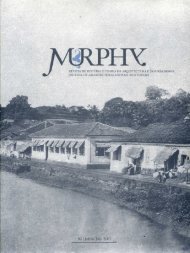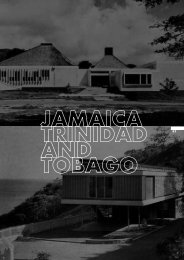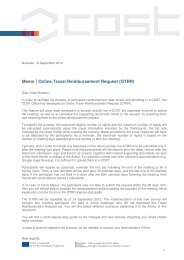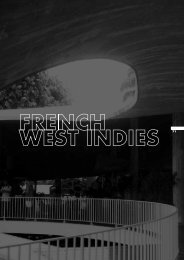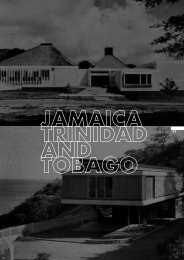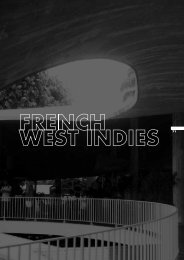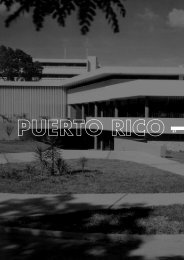Construire au-delà des frontières
Construire au-delà des frontières
Construire au-delà des frontières
You also want an ePaper? Increase the reach of your titles
YUMPU automatically turns print PDFs into web optimized ePapers that Google loves.
« <strong>Construire</strong> <strong>au</strong>-<strong>delà</strong> <strong>des</strong> <strong>frontières</strong> »<br />
notes on mapping, visualizing networks & questions<br />
for WG1<br />
Johan Lagae, Ghent University<br />
10-11 October 2011
Udo Kultermann<br />
Blind gaps in the survey of 20th Century African architecture
<strong>Construire</strong> <strong>au</strong>-<strong>delà</strong> <strong>des</strong> <strong>frontières</strong><br />
Sphères d’influences transnationales dans la production<br />
architecturale en ex-Congo belge.<br />
Johan Lagae, Université de Gand / INHA
Le RDCongo, carrefour de sphères d’influences <strong>au</strong> coeur de l’Afrique
Kinshasa/Léopoldville<br />
Kisangani/Stanleyville<br />
Lubumbashi/Elisabethville<br />
La RDC, un territoire diversifié
Le “bungalow” <strong>au</strong> Congo. Produit d’un “global culture”
« The Indian bungalow is the one perfect house for all tropical<br />
countries », Docteur John Murray, How to live in tropical Africa, 1895
Bungalow démontable de<br />
fabrication anglaise, en usage<br />
dans la région du Bas-Congo
Architecture métallique du XIXe siècle,<br />
érigée à Boma et Mbanza Ngungu
Constructions type bungalow, vers 1911-12, Lubumbashi
E. Leplae, Plans et photographies d’habitations pour plantations coloniales, 1911
E. Leplae, Plans et photographies d’habitations pour plantations coloniales, 1911
G. Boghemans, L’habitation coloniale. Sa construction <strong>au</strong> Congo belge, 1919
“Arabisances” à Kinshasa<br />
La nouvelle résidence du gouverneur-général à Kinshasa et la question d’une style colonial
G. Boghemans, Le bâtiment de la poste à Kinshasa, ca. 1918 (actuellement détruit)
Liège, 1905<br />
Gand, 1913<br />
Anvers, 1930<br />
Paris, 1931<br />
Le Congo belge <strong>au</strong>x expositions internationales et coloniales
Project de concours pour la<br />
résidence du gouverneur-général<br />
à Kinshasa, arch. Raymond<br />
Moenaert, 1928
Project de concours pour la<br />
résidence du gouverneur-général<br />
à Kinshasa, arch. Raymond<br />
Moenaert, 1928
La résidence de la France à Rabat, Maroc, 1918-1924,<br />
arch. A. Laprade & H. Prost
La résidence de la France à Rabat, Maroc, 1918-1924,<br />
arch. A. Laprade & H. Prost
Vers un planning colonial en Afrique subsaharienne
R. Schoentjes, schéma d’une ville Congolaise, 1933
Lubumbashi comme ville ségrégée. L’introduction du<br />
“zone neutre” <strong>au</strong> cours <strong>des</strong> années 1920<br />
1911<br />
1929
Congrès Internationale<br />
‘Urbanisme <strong>au</strong>x Colonies’,<br />
Paris, 1931
Contribution de René Schoentjes <strong>au</strong> Congrès Internationale<br />
‘Urbanisme <strong>au</strong>x Colonies’, Paris, 1931
G. Bardet, Problèmes d’urbanisme, Paris, 1948<br />
Le figure de g<strong>au</strong>che se réfère <strong>au</strong> schéma de la ville congolaise de René Schoentjes
L’émergence d’un “dialect of internationalism”
Proceedings de la Conférence<br />
internationale sur l’architecture<br />
tropicale de Londres, 1953
Scolasticat à Kinshasa, 1958<br />
Arch. P<strong>au</strong>l Dequeker,<br />
formé <strong>au</strong> Department of Tropical Architecture du<br />
Architectural Association School à Londres
Deux numéros thématiques sur l’architecture <strong>au</strong> Congo de la revue belge Rythme,<br />
1949 & 1950
Le Centre spiritualiste de<br />
Pondicherry, Inde, arch. A.<br />
Raymond, 1937-39<br />
Présenté à plusieurs reprises<br />
comme modèle pour la<br />
construction <strong>au</strong> Congo
L’architecture moderne <strong>au</strong> Brésil,<br />
modèle pour l’architecture <strong>au</strong> Congo
“Il nous f<strong>au</strong>t créer une architecture répondant<br />
parfaitement <strong>au</strong>x besoins de l’homme blanc et réduisant<br />
pour lui <strong>au</strong> maximum, les inconvénients d’un climat<br />
hostile. Cette architecture sera vraiment congolaise, elle<br />
sera belle parce que logique et bien adaptée <strong>au</strong>x<br />
conditions de vie spéciales de vie de l’homme moderne<br />
en Afrique”,<br />
Cl<strong>au</strong>de L<strong>au</strong>rens, 1953.
Maxwell Fry & Jane Drew,<br />
Tropical Architecture in the<br />
Humid Zone, Londres, 1956<br />
Les règles de l’habitat, R. Le<br />
Caisne, Techniques &<br />
Architecture, 1952
“Team X” à Lubumbashi
Boeskay flats, Lubumbashi<br />
arch. J. Elliot & P. Charbonnier,<br />
1956-57
Boeskay flats, Lubumbashi<br />
arch. J. Elliot & P. Charbonnier,<br />
1956-57 (situation 2005)
Le monde à Kinshasa
Concours pour le Centre Culturel du Congo belge, Kinshasa, 1958-59.<br />
Richard Neutra, président du jury (<strong>au</strong> milieu)
Centre Culturel du Congo belge, Kinshasa, 1959<br />
projet (non soumis) de Sverre Fehn
Centre Culturel du Congo belge, Kinshasa, 1959<br />
Projet de l’Atelier de Montrouge
Centre Culturel du Congo belge, Kinshasa, 1959<br />
M.J.Z. Polak (Pologne)
Centre Culturel du Congo belge, Kinshasa,<br />
1959<br />
R. Courtois / C. L<strong>au</strong>rens / J. Maes
Centre Culturel du Congo belge, Kinshasa, 1959<br />
Takamasa Yoshizaka (Japon)
Centre Culturel du Congo belge, Kinshasa, 1959<br />
Takamasa Yoshizaka (Japon)
Centre Culturel du Congo belge, Kinshasa, 1959<br />
arch. P. Humblet
En guise de conclusion:<br />
D’une indexation de projets vers une cartographie de trajets
Etude de cas 1: le bungalow tropical (anglais)
Etude de cas 2: “Arabisances” à Kinshasa, le voyage de Raymond Moenaert
Etude de cas 3: Vers un planning colonial
Etude de cas 4: L’émergence d’un “dialect of internationalism”
Etude de cas 5: “Team X” à Lubumbashi
Etude de cas 6: Inventer une architecture africaine contemporaine
<strong>Construire</strong> <strong>au</strong>-<strong>delà</strong> <strong>des</strong> <strong>frontières</strong><br />
The Architectural Association Network in West Africa<br />
Ola Uduku, School of Architecture, Edinburgh College of Art
<strong>Construire</strong> <strong>au</strong>-<strong>delà</strong> <strong>des</strong> <strong>frontières</strong><br />
Portuguese architects abroad.<br />
The cases of Angola and Mozambique.<br />
Madalena Cunha Matos & Tânia Ramos, Technical University of Lisbon
<strong>Construire</strong> <strong>au</strong>-<strong>delà</strong> <strong>des</strong> <strong>frontières</strong><br />
L’expertise architecturale française en Afrique subsaharienne<br />
dans un contexte transnational.<br />
Bernard Toulier, DAPA, Ministère de la culture et de la communication
Ballon Houses<br />
Un modèle américain pour les cités africaines de Dakar et de Kinshasa<br />
Bernard Toulier, conservateur en chef du patrimoine, DAPA, MCC<br />
Table ronde INHA, 19/12/2007 : <strong>Construire</strong> <strong>au</strong>-<strong>delà</strong> <strong>des</strong> <strong>frontières</strong>. Une perspective historique sur<br />
les rése<strong>au</strong>x transnation<strong>au</strong>x d’échange et d’expertise architecturale en Afrique subsaharienne.
Les premières expérimentations pour le logement : coque simple ou double<br />
Wallace Nesh, architecte,<br />
Los Angeles, Californie<br />
(1895-1982)<br />
1941 : Construction d'une douzaine de « Ballon<br />
Houses » à Fall Churchs, Va., pour les travailleurs<br />
<strong>au</strong>xiliaires de la défense par l'architecte Wallace Neff.<br />
Extrait : Washington Post, 15/11/1941<br />
A.N. Sénégal, 4P 3002<br />
1946 : Construction de la Pasadena Shell House (Californie) à<br />
double dome, pour le frère de l'architecte.<br />
Wallace Neff y vécu de 1970 jusqu'à sa mort, en 1982.<br />
Dernière Ballon House subsistante en 2007 <strong>au</strong>x Etats-Unis
Lubumbashi, RDC : une reprise de la maison ballon de Dakar<br />
la maison ballon à Lubumbashi, RDC<br />
M. Bruyère, Contribution à l'étude <strong>des</strong> habitations pour indigènes<br />
<strong>au</strong> Congo belge, Bruxelles, IRCB, 1952, pl.23
Etude de cas 5: “Team X” à Lubumbashi
VISUALIZING NETWORKS OF PEOPLE
visualizing financial networks<br />
Mark Lombardi
MAPPING EXPORT URBANISM FROM POLAND
OVERVIEW (WG1) MEETINGS<br />
- GHENT 31.01-01.02.2011:<br />
methodological talks (prosopography, biography, actor-network<br />
theory)<br />
OASE Africa + Ernst May<br />
digital tools: biographical databases (Vienna / ODIS)<br />
- TORINO 19.04-21.04.2011<br />
- nomadic experts and émigré architects<br />
- cosmopolitan encounters<br />
- diasporic communities<br />
- LIVERPOOL 10.10-11.10.2011
QUESTIONS<br />
1. action WG<br />
going beyond case-studies – building a theoretical/conceptual framework?<br />
widening the geographical scope? Indonesia, India – quid Latin America?<br />
limiting the time-frame: 19th C? post 1945? (modernism/be<strong>au</strong>x-arts)<br />
collaborative articles instead of individual ones? cf. WOG Urban History<br />
output: journal / book / digital tools<br />
STSM: enhancing collaborative research within WG1
QUESTIONS – book/anthology<br />
going beyond case-studies – building a theoretical/conceptual framework?<br />
widening the geographical scope? Indonesia, India – quid Latin America?<br />
limiting the time-frame: 19th C? post 1945? modernism/be<strong>au</strong>x-arts?<br />
STSM: enhancing collaborative research within WG1
STRUCTURE<br />
thematic rather than monographic<br />
1. concepts: exile, agency, locality,...<br />
2. methodological approaches: biographies, networks, ‘geographies’<br />
of practice,...<br />
3. vectors of transnational exchange of expertise: personal<br />
trajectories, conferences, schools, professional networks,<br />
competetions – quid WG2?
texts<br />
1. Verboven (prosoprography), Delbeke (biography), Latour (actornetwork<br />
theory), Hannerz (transnational)<br />
2. Wright (global-local), Duanfang Lu/Prakash (Third World Modernism,<br />
developmentalism,...),<br />
3. Leroux (networks), Chang (networks – science: other agents)<br />
4. Cody (Be<strong>au</strong>x-Arts: .... b<strong>au</strong>h<strong>au</strong>s global....
- european architecture beyond europe? import/export – local agency<br />
- terminology: modernism? comtemporaneity? H. Fathy<br />
- Bandung 1955: Third World Modernism<br />
- clusters? migrant/exile – harvard network –<br />
- multimedia companions to papers



